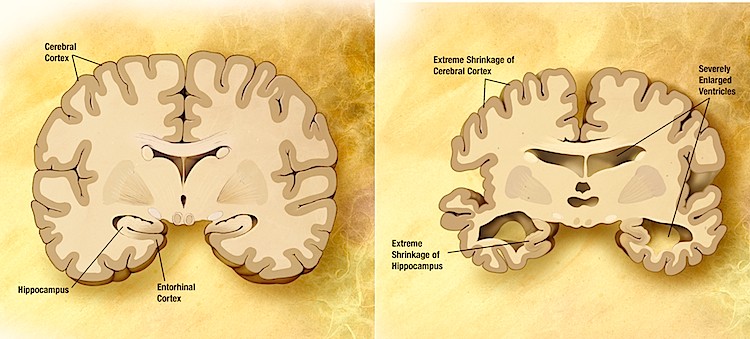As an initiative to raise awareness of Alzheimer’s disease, Alzheimer’s Disease International (ADI) observes World Alzheimer’s Day every year on Sept. 21. This year’s theme is “Faces of Dementia.”
Alzheimer’s associations worldwide will be asking if you recognize the face of dementia and paying tribute to those who represent the “Faces of dementia” to promote increased support and care for sufferers and their carers.
A number of events are organized around the world to support this cause, and are as simple as wearing a purple dress or changing your social networking site’s profile picture to the ‘END ALZ’ icon, as provided on the ADI’s website.
According to the “2011 Alzheimer’s Disease Facts and Figures” report, published in the journal Alzheimer’s & Dementia, “Alzheimer’s disease is the sixth-leading cause of death across all ages in the United States. It is the fifth-leading cause of death for those aged 65 and older.”
The disease is a devastating form of dementia, a general term referring to brain syndromes characterized by problems with memory, judgment, language, orientation, communication, and executive functioning.
Alzheimer’s disease is a progressive, degenerative disease of the brain, leading to memory loss along with multiple thinking and reasoning abnormalities. Eventually, patients become completely dependent on their care givers for daily activities such as dressing and eating.
Scientists have recognized age, heredity, environment, lifestyle, and coexisting medical conditions as the main risk factors that lead to this progressive disorder. High cholesterol, type 2 diabetes, high blood pressure, and heart disease are associated with Alzheimer’s disease.
According to a statement from Nantz National Alzheimer Center at the Methodist Neurological Institute in Houston, Texas, “You can reduce your risk of Alzheimer’s disease and other dementias by eating right, exercising, staying mentally and socially active, and keeping stress in check.”
Contrary to popular belief, Alzheimer’s is not a part of normal aging. It arises from complex abnormal changes in the brain. The changes can be associated with repeated head injuries and other external factors, or related to the genetic make-up of a person.
People have developed Alzheimer’s as early as their thirties. Those who develop the condition young also tend to decline more quickly. Early onset Alzheimer’s seems to be different and far less common than Alzheimer’s affecting elderly people.
If a person has a family history of Alzheimer’s, it adds to their risk, and they are more likely to develop the disorder later in life.
Early symptoms include memory loss, inability to learn new things, confusion about time or place, withdrawal from work and social activities, and mood and behavior changes. The disease progresses to difficulty in speech, swallowing and walking.
Some of these symptoms can be reversed, if they are caused by other factors. Some apparent symptoms of dementia are signs of dehydration, fever, depression, or over-medication for example. A physician’s diagnosis is required to determine the cause of confusion or memory problems.
Currently, there is no complete prevention or cure for Alzheimer’s disease. All available treatments merely work to slow worsening of symptoms.
According to the Nantz Center, “a person develops dementia every 69 seconds.” Their team “are focusing efforts on finding new treatments, as statistics show that as many as 16 million Americans will have Alzheimer’s by the year 2050.”
Alzheimer’s associations worldwide will be asking if you recognize the face of dementia and paying tribute to those who represent the “Faces of dementia” to promote increased support and care for sufferers and their carers.
A number of events are organized around the world to support this cause, and are as simple as wearing a purple dress or changing your social networking site’s profile picture to the ‘END ALZ’ icon, as provided on the ADI’s website.
According to the “2011 Alzheimer’s Disease Facts and Figures” report, published in the journal Alzheimer’s & Dementia, “Alzheimer’s disease is the sixth-leading cause of death across all ages in the United States. It is the fifth-leading cause of death for those aged 65 and older.”
The disease is a devastating form of dementia, a general term referring to brain syndromes characterized by problems with memory, judgment, language, orientation, communication, and executive functioning.
Alzheimer’s disease is a progressive, degenerative disease of the brain, leading to memory loss along with multiple thinking and reasoning abnormalities. Eventually, patients become completely dependent on their care givers for daily activities such as dressing and eating.
Scientists have recognized age, heredity, environment, lifestyle, and coexisting medical conditions as the main risk factors that lead to this progressive disorder. High cholesterol, type 2 diabetes, high blood pressure, and heart disease are associated with Alzheimer’s disease.
According to a statement from Nantz National Alzheimer Center at the Methodist Neurological Institute in Houston, Texas, “You can reduce your risk of Alzheimer’s disease and other dementias by eating right, exercising, staying mentally and socially active, and keeping stress in check.”
Contrary to popular belief, Alzheimer’s is not a part of normal aging. It arises from complex abnormal changes in the brain. The changes can be associated with repeated head injuries and other external factors, or related to the genetic make-up of a person.
People have developed Alzheimer’s as early as their thirties. Those who develop the condition young also tend to decline more quickly. Early onset Alzheimer’s seems to be different and far less common than Alzheimer’s affecting elderly people.
If a person has a family history of Alzheimer’s, it adds to their risk, and they are more likely to develop the disorder later in life.
Early symptoms include memory loss, inability to learn new things, confusion about time or place, withdrawal from work and social activities, and mood and behavior changes. The disease progresses to difficulty in speech, swallowing and walking.
Some of these symptoms can be reversed, if they are caused by other factors. Some apparent symptoms of dementia are signs of dehydration, fever, depression, or over-medication for example. A physician’s diagnosis is required to determine the cause of confusion or memory problems.
Currently, there is no complete prevention or cure for Alzheimer’s disease. All available treatments merely work to slow worsening of symptoms.
According to the Nantz Center, “a person develops dementia every 69 seconds.” Their team “are focusing efforts on finding new treatments, as statistics show that as many as 16 million Americans will have Alzheimer’s by the year 2050.”





